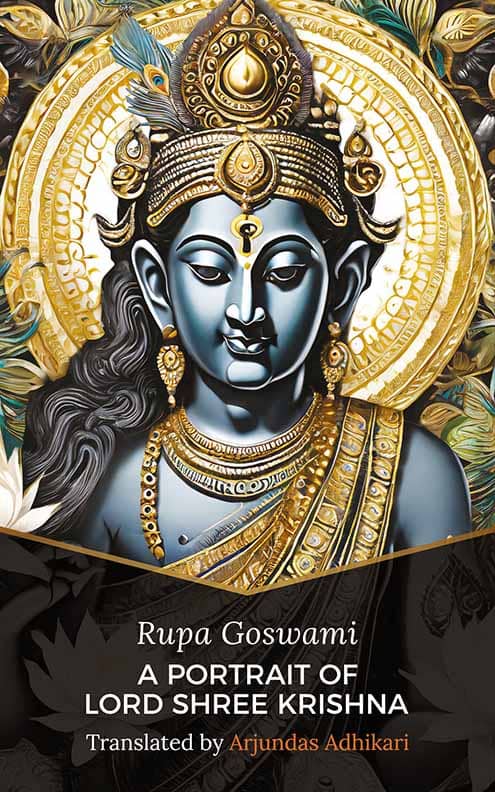
As already noted, there are two principal Sanskrit dramas written by Rupa Goswami, which are Vidagdha Madhava and Lalita Madhava. Titled, A Portrait of Lord Shree Krishna, Vidagdha Madhava has already been published by us in its English language version, while the second is work in progress as a translation. Lord Shree Krishna has many names, but when He is referred to as Madhava, the inference is the Krishna as He is represented in a picture. Generally, the task of a portrait artist is having a shot at representing the truest sense of the subject being painted or drawn. If it happens that an artist is conveying the sense of their subject through a performance-art, like drama, every effort is being made to give the most accurate sense of the subject’s nature by exploring the subject’s character, aims, desires, disposition, relationships, struggles, living environment, contemporaries, loves etc. If the dramatist knows their subject well, there will be nothing but consistency in the manner in which the subject behaves in their play, and that author’s audience will appreciate the truth of the personality of the subject.
In the case of Rupa Goswami’s Sanskrit drama, Vidagdha Madhava, the subject is Lord Shree Krishna (clue being in title – A Portrait of Lord Shree Krishna!). Sanskrit is well-known for having a developed, voluminous vocabulary to cover every nuance of human experience, something awesomely obvious to anyone who comes across epic Sanskrit works like the Ramayana and Mahabharata (each far exceeding the lengths of the Odyssey and Iliad combined), for instance. Adept at using this fantastic language tool, Rupa Goswami was able to portray for us in writing, the truest, most vivid, vital portrait of Lord Shree Krishna ever. But in translating Rupa Goswami’s work into the English language, to do justice to his creation, it is the responsibility of the translator to make sure that that portrait of Lord Shree Krishna isn’t changed. The tell-tale sign that one has not succeeded in this regard is that Krishna’s character will appear contradictory. Rupa Goswami makes no bones about Krishna being anything other than the Supreme Person, for a start. One may not know what a Supreme Person’s exactly like, but the very term ‘Supreme Person’ would indicate somebody great, intelligent, admirable, courageous and attractive. Ignoble, dishonest, unkind, cowardly or licentious aren’t adjectives that spring to mind in imagining what the Supreme Person might be like.
I would like to cite an example from Rupa Goswami’s Lalita Madhava that illustrates how easy it is for Sanskrit to be mistranslated unless proper care is taken:
In act 3 of Lalita Madhava, the cowherd girl Radharani asks a friend if she has seen Krishna. I have seen this passage mistranslated as follows:
O friend, have you seen your friend, the independent-minded prince of Vraja? Has He come here with glistening smiling lips, a flute in His hand, a peacock feather in His hair, and timid eyes glancing at these groves of flowering vines filled with buzzing bees blinded with joy?
Lalita Madhava Act III, 35
To begin with, Krishna is not timid. In the previous act He slew a monster. The Sanskrit words being used do indeed mean ‘timid eyes’, but are followed by ‘as if he had‘ (in Sanskrit – iva). This means that in the company of the cowherd girls, Krishna can appear charmingly diffident. The impression being given in the above translation is of someone glancing nervously about. A sort of timorous figure is being projected – neurotic, even. Secondly, the impression of the description ‘with glistening smiling lips’ has something of cheapness about it. In fact, it isn’t the correct translation; the actual translation for the Sanskrit here – smita-sphuritadha – is just, ‘with a smile on His lips.’
There is also an unpoetic repetition of ‘friend,’ and also, the not including of the casual way that Krishna wears His feather, which leaves us short in appreciating His nonchalance. ‘Bees blinded with joy’ is literal, but ‘busy bees’ is the idea. ‘Bees blinded with joy,’ is plain odd.
Vidagdha Madhava is a masterpiece of a spiritual drama, to be admired as one would admire a musical masterpiece when rendered by serious musicians. Such a work of art deserves such treatment. If wrong notes are played in Beethoven’s 5th, or the timing is out, no matter how great Beethoven might be as a composer, his work may appear not to stand out. For suggesting that Beethoven’s work were in that case being subjected to an injustice wouldn’t be far off the mark.
Arjundas Adhikari

